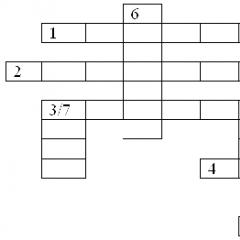How to solve equations using the substitution method. Solving systems of equations. Simple and complex methods for solving systems of equations
2. Method of algebraic addition.
3. Method of introducing a new variable (variable replacement method).
Definition: A system of equations refers to several equations for one or more variables that must be executed simultaneously, i.e. with the same values of the variables for all equations. Equations in the system are combined with a system symbol – a curly brace.
Example 1:
- a system of two equations with two variables x And y.
The solution to the system is the roots. When these values are substituted, the equations become true identities:
Solving systems of linear equations.
The most common method for solving a system is the substitution method.
Substitution method.
The substitution method for solving systems of equations is to express a variable from one equation of the system in terms of others, and substitute this expression into the remaining equations of the system instead of the expressed variable.
Example 2:
Solve the system of equations:
Solution:
A system of equations is given and it needs to be solved by the substitution method.
Let's express the variable y from the second equation of the system.
Comment:“Expressing a variable” means transforming the equality so that this variable remains to the left of the equal sign with a coefficient of 1, and all other terms move to the right side of the equality.
Second equation of the system:
Let's leave only on the left y:
And let’s substitute (that’s where the name of the method comes from) into the first equation instead of at the expression to which it is equal, i.e. .
First equation:
Let's substitute: ![]()
Let's solve this banal quadratic equation. For those who have forgotten how to do this, there is an article Solving quadratic equations. . 
So the variable values x found.
Let's substitute these values into the expression for the variable y. There are two meanings here x, i.e. for each of them you should find a value y .
1) Let
We substitute it into the expression.
2) Let
We substitute it into the expression.
Everything can be answered:
Comment: In this case, the answer should be written in pairs so as not to confuse which value of the variable y corresponds to which value of the variable x.
Answer:
Comment: In example 1, only one pair is indicated as a solution to the system, i.e. this pair is a solution to the system, but not a complete one. Therefore, how to solve an equation or system means indicating the solution and showing that there are no other solutions. And here's another couple.
Let’s formalize the solution to this system in a school style:
Comment: The sign “” means “equivalently”, i.e. the next system or expression is equivalent to the previous one.
Let us analyze two types of solutions to systems of equations:
1. Solving the system using the substitution method.
2. Solving the system by term-by-term addition (subtraction) of the system equations.
In order to solve the system of equations by substitution method you need to follow a simple algorithm:
1. Express. From any equation we express one variable.
2. Substitute. We substitute the resulting value into another equation instead of the expressed variable.
3. Solve the resulting equation with one variable. We find a solution to the system.
To decide system by term-by-term addition (subtraction) method need to:
1. Select a variable for which we will make identical coefficients.
2. We add or subtract equations, resulting in an equation with one variable.
3. Solve the resulting linear equation. We find a solution to the system.
The solution to the system is the intersection points of the function graphs.
Let us consider in detail the solution of systems using examples.
Example #1:
Let's solve by substitution method
Solving a system of equations using the substitution method2x+5y=1 (1 equation)
x-10y=3 (2nd equation)
1. Express
It can be seen that in the second equation there is a variable x with a coefficient of 1, which means that it is easiest to express the variable x from the second equation.
x=3+10y
2.After we have expressed it, we substitute 3+10y into the first equation instead of the variable x.
2(3+10y)+5y=1
3. Solve the resulting equation with one variable.
2(3+10y)+5y=1 (open the brackets)
6+20y+5y=1
25y=1-6
25y=-5 |: (25)
y=-5:25
y=-0.2
The solution to the equation system is the intersection points of the graphs, therefore we need to find x and y, because the intersection point consists of x and y. Let's find x, in the first point where we expressed it we substitute y.
x=3+10y
x=3+10*(-0.2)=1
It is customary to write points in the first place we write the variable x, and in the second place the variable y.
Answer: (1; -0.2)
Example #2:
Let's solve using the term-by-term addition (subtraction) method.
Solving a system of equations using the addition method3x-2y=1 (1 equation)
2x-3y=-10 (2nd equation)
1. We choose a variable, let’s say we choose x. In the first equation, the variable x has a coefficient of 3, in the second - 2. We need to make the coefficients the same, for this we have the right to multiply the equations or divide by any number. We multiply the first equation by 2, and the second by 3 and get a total coefficient of 6.
3x-2y=1 |*2
6x-4y=2
2x-3y=-10 |*3
6x-9y=-30
2. Subtract the second from the first equation to get rid of the variable x. Solve the linear equation.
__6x-4y=2
5y=32 | :5
y=6.4
3. Find x. We substitute the found y into any of the equations, let’s say into the first equation.
3x-2y=1
3x-2*6.4=1
3x-12.8=1
3x=1+12.8
3x=13.8 |:3
x=4.6
The intersection point will be x=4.6; y=6.4
Answer: (4.6; 6.4)
Do you want to prepare for exams for free? Tutor online for free. No joke.
IN in this case It is convenient to express x from the second equation of the system through y and substitute the resulting expression instead of x in the first equation:
![]()
The first equation is an equation with one variable y. Let's solve it:
5(7-3y)-2y = -16
We substitute the resulting y value into the expression for x:
![]()
Answer: (-2; 3).
![]()
In this system, it is easier to express y in terms of x from the first equation and substitute the resulting expression instead of y in the second equation:
![]()
![]()
The second equation is an equation with one variable x. Let's solve it:
3x-4(-1.5-3.5x)=23
In the expression for y, instead of x, we substitute x=1 and find y:
Answer: (1; -5).
![]()
Here it is more convenient to express y in terms of x from the second equation (since dividing by 10 is easier than dividing by 4, -9 or 3):
![]()
![]()
Let's solve the first equation:
4x-9(1.6-0.3x)= -1
4x-14.4+2.7x= -1
Substitute x=2 and find y:
Answer: (2; 1).
![]()
Before applying the substitution method, this system should be simplified. Both sides of the first equation can be multiplied by the lowest common denominator, in the second equation we open the brackets and present similar terms:

![]()
Got the system linear equations with two variables. Now let's apply the substitution. It is convenient to express a through b from the second equation:
![]()
![]()
We solve the first equation of the system:
3(21.5 + 2.5b) – 7b = 63
It remains to find the value of a:
According to the formatting rules, we write the answer in parentheses separated by a semicolon in alphabetical order.
Answer: (14; -3).
When expressing one variable through another, it is sometimes more convenient to leave it with a certain coefficient.
![]()
Usually the equations of the system are written in a column one below the other and combined with a curly brace
A system of equations of this type, where a, b, c- numbers, and x, y- variables are called system of linear equations.
When solving a system of equations, properties that are valid for solving equations are used.
Solving a system of linear equations using the substitution method
Let's look at an example ![]()
1) Express the variable in one of the equations. For example, let's express y in the first equation, we get the system:
2) Substitute into the second equation of the system instead of y expression 3x-7:

3) Solve the resulting second equation:
4) We substitute the resulting solution into the first equation of the system:
A system of equations has a unique solution: a pair of numbers x=1, y=-4. Answer: (1; -4) , written in brackets, in the first position the value x, on the second - y.
Solving a system of linear equations by addition
Let's solve the system of equations from the previous example ![]() addition method.
addition method.
1) Transform the system so that the coefficients for one of the variables become opposite. Let's multiply the first equation of the system by "3".

2) Add the equations of the system term by term. We rewrite the second equation of the system (any) without changes.

3) We substitute the resulting solution into the first equation of the system:

Solving a system of linear equations graphically
The graphical solution of a system of equations with two variables comes down to finding the coordinates common points equation graphs.
The graph of a linear function is a straight line. Two straight lines on a plane can intersect at one point, be parallel, or coincide. Accordingly, a system of equations can: a) have a unique solution; b) have no solutions; c) have an infinite number of solutions.
2) The solution to the system of equations is the point (if the equations are linear) of the intersection of the graphs.
Graphic solution of the system ![]()

Method for introducing new variables
Changing variables can lead to solving a simpler system of equations than the original one.
Consider the solution of the system
Let's introduce the replacement , then

Let's move on to the initial variables

Special cases
Without solving a system of linear equations, you can determine the number of its solutions from the coefficients of the corresponding variables.
A system of linear equations with two unknowns is two or more linear equations for which it is necessary to find all of them general solutions. We will consider systems of two linear equations in two unknowns. The general view of a system of two linear equations with two unknowns is presented in the figure below:
( a1*x + b1*y = c1,
( a2*x + b2*y = c2
Here x and y are unknown variables, a1,a2,b1,b2,c1,c2 are some real numbers. A solution to a system of two linear equations in two unknowns is a pair of numbers (x,y) such that if we substitute these numbers into the equations of the system, then each of the equations of the system turns into a true equality. Consider one of the ways to solve a system of linear equations, namely the substitution method.
Solution algorithm by substitution method
Algorithm for solving a system of linear equations using the substitution method:
1. Choose one equation (it is better to choose the one where the numbers are smaller) and express one variable from it in terms of another, for example, x in terms of y. (you can also use y through x).
2. Substitute the resulting expression instead of the corresponding variable into another equation. Thus, we get a linear equation with one unknown.
3. Solve the resulting linear equation and obtain a solution.
4. We substitute the resulting solution into the expression obtained in the first paragraph, and obtain the second unknown from the solution.
5. Check the resulting solution.
Example
To make it more clear, let's solve a small example.
Example 1. Solve the system of equations:
(x+2*y =12
(2*x-3*y=-18
Solution:
1. From the first equation of this system we express the variable x. We have x= (12 -2*y);
2. Substitute this expression into the second equation, we get 2*x-3*y=-18; 2*(12 -2*y) - 3*y = -18; 24 - 4y - 3*y = -18;
3. Solve the resulting linear equation: 24 - 4y - 3*y = -18; 24-7*y =-18; -7*y = -42; y=6;
4. Substitute the result obtained into the expression obtained in the first paragraph. x= (12 -2*y); x=12-2*6 = 0; x=0;
5. We check the resulting solution; to do this, we substitute the found numbers into the original system.
(x+2*y =12;
(2*x-3*y=-18;
{0+2*6 =12;
{2*0-3*6=-18;
{12 =12;
{-18=-18;
We got the correct equalities, therefore, we found the solution correctly.



